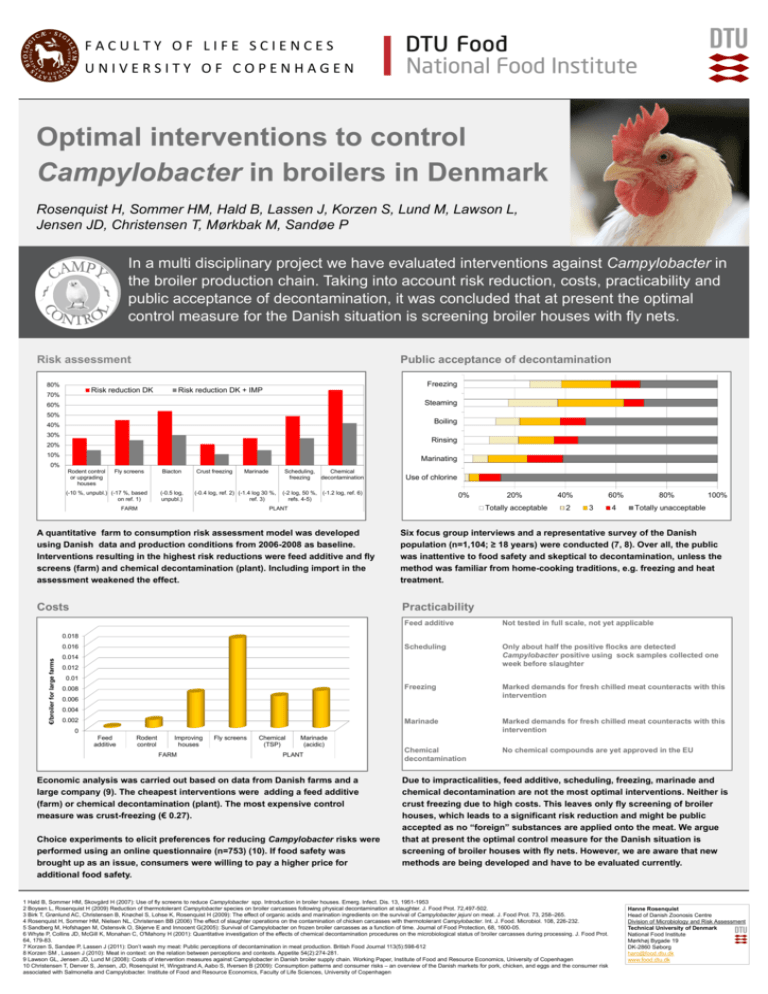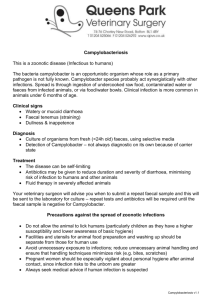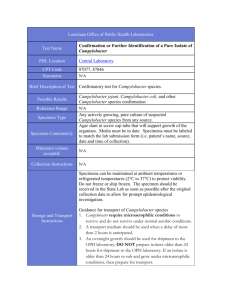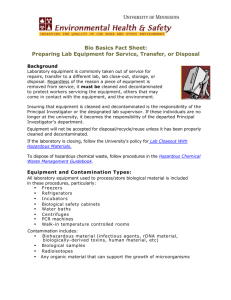Titel (3 varianter Arial Bold 1. 100/120pt, 2. 160/170pt, 3. 200/220pt. )
advertisement

FACULTY OF LIFE SCIENCES UNIVERSITY OF COPENHAGEN Optimal interventions to control Campylobacter in broilers in Denmark Rosenquist H, Sommer HM, Hald B, Lassen J, Korzen S, Lund M, Lawson L, Jensen JD, Christensen T, Mørkbak M, Sandøe P In a multi disciplinary project we have evaluated interventions against Campylobacter in the broiler production chain. Taking into account risk reduction, costs, practicability and public acceptance of decontamination, it was concluded that at present the optimal control measure for the Danish situation is screening broiler houses with fly nets. Risk assessment 80% Public acceptance of decontamination Risk reduction DK 70% Freezing Risk reduction DK + IMP Steaming 60% 50% Boiling 40% 30% Rinsing 20% 10% Marinating 0% Rodent control or upgrading houses Fly screens (-10 %, unpubl.) (-17 %, based on ref. 1) Biacton (-0.5 log, unpubl.) Crust freezing Marinade Scheduling, freezing (-0.4 log, ref. 2) (-1.4 log 30 %, ref. 3) FARM Chemical decontamination Use of chlorine (-2 log, 50 %, (-1.2 log, ref. 6) refs. 4-5) 0% 20% Totally acceptable PLANT 40% 2 60% 3 4 80% 100% Totally unacceptable A quantitative farm to consumption risk assessment model was developed using Danish data and production conditions from 2006-2008 as baseline. Interventions resulting in the highest risk reductions were feed additive and fly screens (farm) and chemical decontamination (plant). Including import in the assessment weakened the effect. Six focus group interviews and a representative survey of the Danish population (n=1,104; ≥ 18 years) were conducted (7, 8). Over all, the public was inattentive to food safety and skeptical to decontamination, unless the method was familiar from home-cooking traditions, e.g. freezing and heat treatment. Costs Practicability Feed additive Not tested in full scale, not yet applicable Scheduling Only about half the positive flocks are detected Campylobacter positive using sock samples collected one week before slaughter Freezing Marked demands for fresh chilled meat counteracts with this intervention Marinade Marked demands for fresh chilled meat counteracts with this intervention Chemical decontamination No chemical compounds are yet approved in the EU 0.018 €/broiler for large farms 0.016 0.014 0.012 0.01 0.008 0.006 0.004 0.002 0 Feed additive Rodent control Improving houses FARM Fly screens Chemical (TSP) Marinade (acidic) PLANT Economic analysis was carried out based on data from Danish farms and a large company (9). The cheapest interventions were adding a feed additive (farm) or chemical decontamination (plant). The most expensive control measure was crust-freezing (€ 0.27). Choice experiments to elicit preferences for reducing Campylobacter risks were performed using an online questionnaire (n=753) (10). If food safety was brought up as an issue, consumers were willing to pay a higher price for additional food safety. Due to impracticalities, feed additive, scheduling, freezing, marinade and chemical decontamination are not the most optimal interventions. Neither is crust freezing due to high costs. This leaves only fly screening of broiler houses, which leads to a significant risk reduction and might be public accepted as no “foreign” substances are applied onto the meat. We argue that at present the optimal control measure for the Danish situation is screening of broiler houses with fly nets. However, we are aware that new methods are being developed and have to be evaluated currently. 1 Hald B, Sommer HM, Skovgård H (2007): Use of fly screens to reduce Campylobacter spp. Introduction in broiler houses. Emerg. Infect. Dis. 13, 1951-1953 2 Boysen L, Rosenquist H (2009) Reduction of thermotolerant Campylobacter species on broiler carcasses following physical decontamination at slaughter. J. Food Prot. 72,497-502. 3 Birk T, Grønlund AC, Christensen B, Knøchel S, Lohse K, Rosenquist H (2009): The effect of organic acids and marination ingredients on the survival of Campylobacter jejuni on meat. J. Food Prot. 73, 258–265. 4 Rosenquist H, Sommer HM, Nielsen NL, Christensen BB (2006) The effect of slaughter operations on the contamination of chicken carcasses with thermotolerant Campylobacter. Int. J. Food. Microbiol. 108, 226-232. 5 Sandberg M, Hofshagen M, Ostensvik O, Skjerve E and Innocent G(2005): Survival of Campylobacter on frozen broiler carcasses as a function of time. Journal of Food Protection, 68, 1600-05. 6 Whyte P, Collins JD, McGill K, Monahan C, O'Mahony H (2001): Quantitative investigation of the effects of chemical decontamination procedures on the microbiological status of broiler carcasses during processing. J. Food Prot. 64, 179-83. 7 Korzen S, Sandøe P, Lassen J (2011): Don’t wash my meat: Public perceptions of decontamination in meat production. British Food Journal 113(5):598-612 8 Korzen SM , Lassen J (2010): Meat in context: on the relation between perceptions and contexts. Appetite 54(2):274-281. 9 Lawson GL, Jensen JD, Lund M (2008): Costs of intervention measures against Campylobacter in Danish broiler supply chain. Working Paper, Institute of Food and Resource Economics, University of Copenhagen 10 Christensen T, Denver S, Jensen, JD, Rosenquist H, Wingstrand A, Aabo S, Ifversen B (2009): Consumption patterns and consumer risks – an overview of the Danish markets for pork, chicken, and eggs and the consumer risk associated with Salmonella and Campylobacter. Institute of Food and Resource Economics, Faculty of Life Sciences, University of Copenhagen Hanne Rosenquist Head of Danish Zoonosis Centre Division of Microbiology and Risk Assessment Technical University of Denmark National Food Institute Mørkhøj Bygade 19 DK-2860 Søborg haro@food.dtu.dk www.food.dtu.dk



